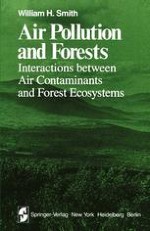1981 | OriginalPaper | Buchkapitel
Class II Summary: Forest Responds by Exhibiting Alterations in Growth, Biomass, Species Composition, Disease, and Insect Outbreaks
verfasst von : William H. Smith
Erschienen in: Air Pollution and Forests
Verlag: Springer US
Enthalten in: Professional Book Archive
Aktivieren Sie unsere intelligente Suche, um passende Fachinhalte oder Patente zu finden.
Wählen Sie Textabschnitte aus um mit Künstlicher Intelligenz passenden Patente zu finden. powered by
Markieren Sie Textabschnitte, um KI-gestützt weitere passende Inhalte zu finden. powered by
In the presence of a sufficient dose of an air pollutant, forest trees will be adversely impacted. When this occurs the threshold between Class I and Class II interactions is crossed. At intermediate dose, the specific contaminant concentration and time of exposure varying greatly with specific pollutant and forest situation, the influence on individual forest components may range from extremely subtle to visibly dramatic. Chapters 7 through 14 have reviewed the evidence available to support the hypotheses that intermediate air pollution loads may alter or inhibit forest tree reproduction, alter forest nutrient cycling, alter tree metabolism, or change forest stress conditions by influencing insect pests, microbial pathogens, and by directly damaging foliar tissue. All but the latter of these impacts would be extremely subtle, visibly asymptomatic, and detectable only by very careful forest monitoring.
